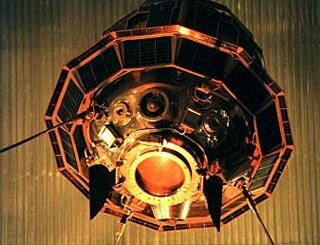

Оглавление РефератыThe MoonIII Exploration of the Moon - Luna 3 (Luna E-3)Luna 3 (Luna E-3)
Looped around the moon and photographed the Moon's far side. The craft was a cylindrically shaped cannister which was equipped with radio communication and telemetering systems, an imaging system with an automatic film processing unit, a set of scientific instruments, three solar cells for electric power supply, and a temperature control system. It had gas jets for stabilization and photoelectric cells to maintain orientation with respect to the Sun and Moon. This spacecraft was controlled by radio command from Earth. It was launched on a figure-eight trajectory which brought it over the Moon (closest approach to the Moon was 6200 km) and around the far side, which was sunlit at the time. It was stabilized while in optical view of the far side of the Moon. The spacecraft returned very indistinct pictures, but, through computer enhancement, a tentative atlas of the lunar farside was produced. These first views of the lunar far side showed mountainous terrain, very different from the near side, and two dark regions which were named Mare Moscovrae (Sea of Moscow) and Mare Desiderii (Sea of Dreams). Luna 3 was the third spacecraft successfully launched to the Moon and the first to return images of the lunar far side. It was launched on a figure-eight trajectory which brought it over the Moon (closest approach to the Moon was 6200 km) and around the far side, which was sunlit at the time. It was stabilized while in optical view of the far side of the Moon. On October 7, 1959, the television system obtained a series of 29 photographs over 40 minutes, covering 70% of the surface, that were developed on-board the spacecraft. The photographs were scanned and 17 were radio transmitted to ground stations in facsimile form on October 18, 1959, as the spacecraft, in a barycentric orbit, returned near the Earth. The photographs were to be retransmitted at another point close to Earth but were not received. The spacecraft returned very indistinct pictures, but, through computer enhancement, a tentative atlas of the lunar farside was produced. These first views of the lunar far side showed mountainous terrain, very different from the near side, and two dark regions which were named Mare Moscovrae (Sea of Moscow) and Mare Desiderii (Sea of Dreams). Reached an altitude of 200,000 km before plunging back to earth. This dramatic failure resulted in a loss of thrust, and the lateral strap-on units separated and flew over the tracking stations and living areas. The core continued on its trajectory. |
|
Конкурс рефератов: Тема: The Moon Автор : БАННЕРЫ: |

